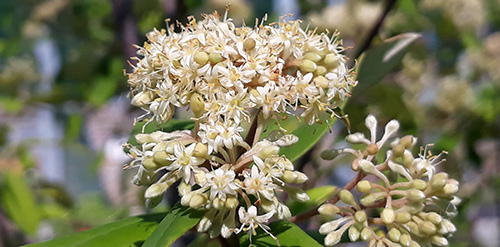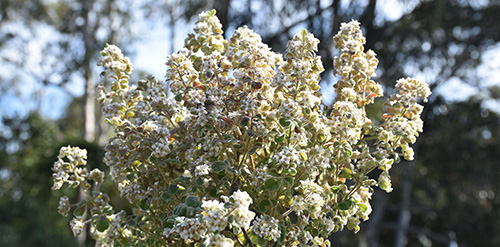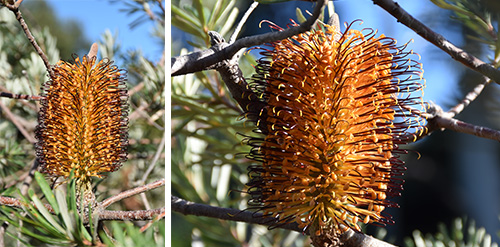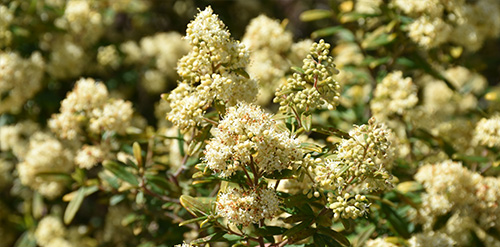As part of our conservation efforts, we participate in the South East NSW Bioregion Working Group. This partnership includes representatives from various national and regional botanic gardens, state government and other partner organisations.
We collect and propagate endangered species to support scientific research and conservation and hold ex-situ collections to help safeguard wild populations, including:
Key stats:
- Status: Critically Endangered.
- 200+ plants have been replanted into wild sites (more than tripling naturally occurring wild numbers)
- Approximately 100 plants are held in ex-situ collections at Wollongong Botanic Garden, constantly under propagation.

Carrington Falls Pomaderris (Pomaderris walshii) is a critically endangered plant and is endemic to NSW - that means it's only found growing here and nowhere else in the world. There are only about 80 individuals growing in the wild in and around Budderoo National Park. In the wild there is an extremely low rate of new seedlings growing up in the understory.
NSW National Parks and Wildlife Service has been working with this critically threatened species for almost 20 years. In 2015, Wollongong Botanic Garden joined efforts to protect this plant, working with NSW National Parks and Wildlife and the Office of Environment and Heritage / Department of Industry Planning and Environment, and with support from the Saving Our Species Program.
Our team collected cuttings to build an ex-situ collection (one that is outside its natural population). Having an ex-situ conservation collection allows us to create a 'back up' for this species. This could be important if anything goes wrong with the wild population, like a fire or major flood. This species has a very small natural range, so a major flood or fire could devastate the whole species in the wild. In the last few years there have been a few floods which have caused a lot of damage to the wild population, highlighting the importance of having back up ex-situ holdings.
Our ex-situ collection also supports research projects, which means researchers do not have to access or damage the wild population to get samples to work on. Research carried out with this species from ex-situ holdings included genetic research to understand how diverse and ‘healthy’ this small population is. Other research includes how the seeds respond to fire, and whether this species has evolved to withstand fire. This can help us understand if other treatments can support this species to naturally regenerate in the wild, like small controlled burns or similar measures.
Since we've been propagating this species, we've added a few hundred to our ex-situ holdings. In November 2018, more than 100 of these were replanted into the wild in eight different locations to test ideal planting conditions. This data helped inform future re-introductions of this species. In August 2019 another 100+ plants went out into the wild, effectively tripling the wild population across these two plantings.
All this work is being done to safeguard this critically endangered species into the future. This project is a great example of different organisations working together to get positive conservation outcomes.
Key stats:
- Status: Endangered.
- 20 plants are held in ex-situ collections at Wollongong Botanic Garden, constantly under propagation.
- Seed collections by Wollongong Botanic Garden staff from wild plants have also been deposited into National Seed Banks.
Sublime Point Pomaderris (Pomaderris adnata) is an Endangered species endemic to NSW, found growing around Sublime Point on the Illawarra Escarpment. This shrub can grow up to two meters high, and is found growing on or near the edge of the escarpment on sandy loam soils over sandstone.
The adult plants of this species are killed by fire, but its seed can survive fire in the soil seedbank and germinate following fire.
At Wollongong Botanic Garden we have worked with our partners in the South East NSW Bioregion Working Group with Environment Trust funding to research and conserve this species. We keep and maintain an ex-situ collection representing a cross section of the wild population. This collection is duplicated as a 'backup' at other partner gardens for safety, and wider seed collections have been made and banked in the National Seed Bank.
Because it has a small population number and only grows across one small area, this species is at risk from many factors, particularly natural catastrophes like bushfires. This highlights the importance of ex-situ collections and seed banking to safeguard this species into the future.
Key stats:
- Status: Endangered.
- 300+ plants have been replanted into wild sites for research.
- 100 plants are held in ex-situ collections at Wollongong Botanic Garden, constantly under propagation.

In 2017, more than 300 endangered Bomaderry Zieria (Zieria baeuerlenii) that were grown at the Wollongong Botanic Garden were planted back into the wild. This species is endemic to NSW (only found growing here and nowhere else in the world).
Sadly, the following year a large bushfire went through the replanted and wild population, burning most of the planted area. This was a big setback and loss for this endangered species.
Amazingly, some of these plants (both wild and replanted) are showing their ability to survive and are re-shooting from their root plates underground.
This example highlights the important role of botanic gardens to hold plants to safeguard these threatened species.
Key stats:
- Status: Critically Endangered.
- Approximately 70 plants are held in ex-situ collections at Wollongong Botanic Garden for ongoing research, and as a safeguard for the wild population in future re-plantings.

Only discovered in 2008, then described and published as a new species in 2014, this is probably the rarest Banksia in Australia. It is listed as Critically Endangered. It is endemic to NSW (only found growing here and nowhere else in the world).
Banksia vincentia is found growing in low sedgeland and grassy heath in sandy soils over clay on sandstone. Originally a population of only 14 plants were discovered, but today only four individual plants survive in the wild; the others have been lost to bushfires and extended periods of inundation. Luckily some of these individuals are represented in the ex-situ holdings of this species.
This species may be able to survive infrequent low intensity burns, re-sprouting from an underground lignotuber. However if the fires are too intense or too frequent, the adult plant will be killed. Its survival strategy in this case is to release seeds from the fruiting cones after fire, starting a new population.
At Wollongong Botanic Garden we have been working closely with Booderee Botanic Garden (as the lead partner) and Australian National Botanic Garden (Canberra) to propagate this species. We have collaborated on how best to propagate this species by cuttings and our ex-situ collections have been used to support genetic research into this species. We have also collaborated with the Office of Environment and Heritage / Department of Planning Industry and Environment with research surrounding pollination of this species to try and increase the yield of seed from wild and cultivated specimens.
With fires and inundation both possible in the wild population, having an ex-situ collection and seeds banked all help safeguard this species into the future.
Key stats:
- Status: Vulnerable
The Biconvex Paperbark (Melaleuca biconvexa) is a shrub or small tree up to 10 meters high. It is listed as Vulnerable and is endemic to NSW (only found growing here and nowhere else in the world). It is found in the wild in scattered populations from around Jervis Bay in the south, to Gosford in the north. It occurs in damp low-lying areas and alongside streams.
Germination trials have been carried out on behalf of the Office of Environment and Heritage / Department of Planning Infrastructure and Environment to research this species. These trials were to investigate whether the seed of this species is naturally ‘stored’ in the soil seed bank underneath existing plants, and to research germination rates from fresh seed collected directly from the plants.
You can also visit our Rare and Threatened Plant Collection located between the Towri Centre and Administration Building, which displays a number of rare and threatened local and Australian plants to the public.

